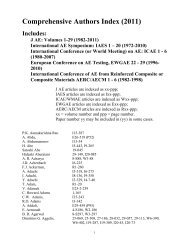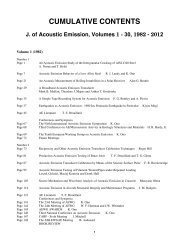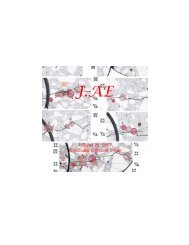Journal of AE, Volume 23, 2005 (ca. 43 MB) - AEWG
Journal of AE, Volume 23, 2005 (ca. 43 MB) - AEWG
Journal of AE, Volume 23, 2005 (ca. 43 MB) - AEWG
You also want an ePaper? Increase the reach of your titles
YUMPU automatically turns print PDFs into web optimized ePapers that Google loves.
code [3-5]. The level <strong>of</strong> numeri<strong>ca</strong>l noise in the <strong>AE</strong> signals obtained from the code is less by approximatelythree orders <strong>of</strong> magnitude than the typi<strong>ca</strong>l out-<strong>of</strong>-plane displacement signal levelsproduced by the code.Since real <strong>AE</strong> signals normally have signifi<strong>ca</strong>nt electronic noise that is superimposed on the<strong>AE</strong> source-based signal, the purpose <strong>of</strong> the research reported here was to determine the effects <strong>of</strong>electronic (sensor/preamplifier-based) noise on the accuracy <strong>of</strong> WT-based arrival times. The finiteelement model results are ideal for such a study since the noise-free signals are available.This situation is not the <strong>ca</strong>se with experimental <strong>AE</strong> signals. Further, with experimental signalsthe exact lo<strong>ca</strong>tion <strong>of</strong> the source is unknown, while for the finite-element signals the precise lo<strong>ca</strong>tions<strong>of</strong> the source and pseudo sensor(s) are known.2. Finite Element Modeled <strong>AE</strong> Signal DatabaseThe signal database used in the research reported here has been described in previous publi<strong>ca</strong>tions[1, 2, 6 and 7]. To provide a ready reference to key information, certain aspects aresummarized here. The signals were generated by finite-element modeling (FEM) in an aluminumplate (1 m x 1 m x 4.7 mm). The <strong>AE</strong> signals represent the out-<strong>of</strong>-plane top-surface displacementas recorded by a perfect flat-with-frequency point-contact sensor. The <strong>AE</strong> signalswere modeled for three in-plane propagation distances (60 mm, 120 mm and 180 mm from thesource epicenter) and seven in-plane radiation angles (0° [x-direction], 12°, 22.5°, 45°, 67.5°,78°, and 90° [y-direction]). All the FEM signals were numeri<strong>ca</strong>lly processed with a 40 kHz(four-pole Butterworth) high-pass filter followed by resampling from 44.6 ns/point to 0.1s/point. The <strong>AE</strong> signals were based on a 1.5 s source rise time, and they were examined out to150 s after the source operation time. This procedure avoids the plate edge reflections, whichappear well after the direct signals.Table 1 provides pertinent information on the buried dipole-type <strong>AE</strong> sources used for a detailedexamination <strong>of</strong> the effects <strong>of</strong> electronic sensor/preamplifier noise. Initially the study focusedon data at a propagation distance <strong>of</strong> 180 mm and a radiation direction <strong>of</strong> 0˚. The six FEM<strong>ca</strong>ses described in the table were selected based upon the desire to include <strong>AE</strong> signal <strong>ca</strong>ses withthe following features. First, an <strong>AE</strong> signal where its primary energy (as evaluated by a WT) wasin the low frequency region <strong>of</strong> the fundamental antisymmetric Lamb mode. Second, a <strong>ca</strong>sewhere the primary signal energy was in the high frequency portion <strong>of</strong> the fundamental symmetricLamb mode. Third, a <strong>ca</strong>se where the primary-signal energy was approximately equally distributedbetween these two portions <strong>of</strong> the fundamental modes. And fourth, additional <strong>ca</strong>ses so thateach <strong>of</strong> the three selected source types was represented at two source depths. The source typesselected were an in-plane dipole (aligned in the 0º direction), a microcrack initiation (with theprimary dipole in the 0º direction), and a shear (without a moment) about the y-axis with theshear directions at 45˚ to the x and z axes. Previous research [1, 7] had identified the primary WTsignal energy for this plate and these <strong>AE</strong> sources to be at the mode and key frequency combinations<strong>of</strong> A 0 at 60 kHz and S 0 at 522 kHz. Table 1 specifies the dominant mode and frequencycombination(s) for each <strong>ca</strong>se <strong>of</strong> source type and source depth. The table also provides the relevantaverage group velocities [1, 7] and the ratio <strong>of</strong> the WT peak magnitudes (for each <strong>ca</strong>se) <strong>of</strong>the two mode and frequency combinations.2








